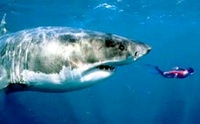
Some researchers questioned the reliability of both measurements, noting they were much larger than any other accurately-reported Great White Shark. The New Brunswick shark may have been a misidentified basking shark, as both sharks have similar body shapes. The question of the Port Fairy shark was settled in the 1970s, when J.E. Reynolds examined the shark`s jaws and "found that the Port Fairy shark was of the order of 5 m (17 feet) in length and suggested that a mistake had been made in the original record, in 1870, of the shark`s length. Ellis and McCosker write that "the largest White Sharks accurately measured range between 19 and 21 ft [about 5.8 to 6.4 m], and there are some questionable 23-footers [about 7 m] in the popular — but not the scientific — literature". Furthermore, they add that "these giants seem to disappear when a responsible observer approaches with a tape measure." (For more about legendary exaggerated shark measurements, see the submarine). The largest specimen Ellis and McCosker endorse as reliably measured was 6.4 metres (21.3 ft) long, caught in Cuban waters in 1945; though confident in their opinion, Ellis and McCosker note other experts have argued this individual might have been a few feet shorter. There have since been claims of larger Great White Sharks, but, as Ellis and McCosker note, verification is often lacking and these extraordinarily large great white sharks have, upon examination, all proved under the 20-21 ft limit. For example, a much-publicized female Great White said to be 7.13 metres (over 23 ft) was fished in Malta in 1987 by Alfredo Cutajar. In their book, Ellis and McCosker agree this shark seemed to be larger than average, but they did not endorse the 7.13 metres measurement. In the years since, experts eventually found reason to doubt the claim, due in no small part to conflicting accounts offered by Cutajar and others. A BBC photo analyst concluded that even "allowing for error ... the shark is concluded to be in the 18.3 ft [5.5 m] range and in no way approaches the 23 ft [7 m] reported by Abela." (as in original) According to the Canadian Shark Research Centre, the largest accurately measured Great White Shark was a female caught in August 1988 at Prince Edward Island off the Canadian (North Atlantic) coast and measured 6.1 metres (20.3 ft). The shark was caught by David McKendrick, a local resident from Alberton, West Prince. The question of maximum weight is complicated by an unresolved question: when weighing a Great White Shark, does one account for the weight of the shark`s recent meals? With a single bite, a Great White can take in up to 14 kilograms (30 lb) of flesh, and can gorge on several hundred kilograms or pounds of food. Ellis and McCosker write in regards to modern Great White Sharks that "it is likely that [Great White] sharks can weigh as much as 2 tons", but also note that the largest recent scientifically measured examples weigh in at about 2 tonnes (1.75 short tons). The largest Great White Shark recognized by the International Game Fish Association (IGFA) is one landed by Alf Dean in south Australian waters in 1959, weighing 1,208 kilograms (2,664 lb). Several larger Great White Sharks caught by anglers have since been verified, but were later disallowed from formal recognition by IGFA monitors for rules violations.